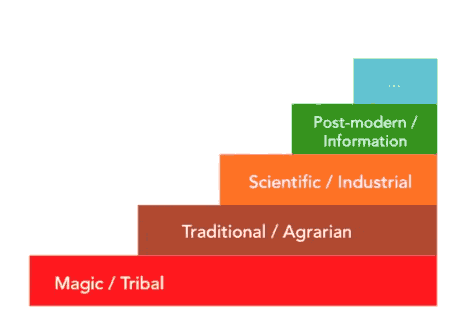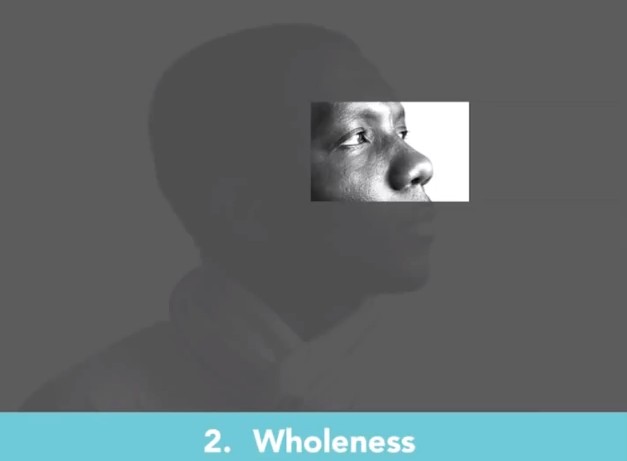There’s a new way of organizing and collaborating emerging around the globe – as Frederic Laloux shows in his book Reinventing Organizations. Let’s take a closer look at “new organizations” with a case study – and examine the three key things that they do differently: self-management, wholeness, and purpose.
As I discussed in last week’s blog, organizational evolution matches the stages of human development. In short: Collaboration in the magic-tribal red phase looked like one tribe with a chief. They hunt-gather and fight the other tribes – trying to dominate. The metaphor: wolf packs. Then we created the agrarian revolution, 5000 years ago, and evolved toward amber organizations. They are structured with one boss, one god and laws. They are hierarchical and stable. The metaphor: armies.
The scientific revolution led to orange organizations. People started to think instead of trust authority blindly. They understood they could make more profit if they were faster, used their thinking and innovated. The metaphor: machines.
Our post-modern information age gave birth to more green organizations. People aren’t just productivity factors – soft skills become important in service and collaboration. Culture becomes important. The assumption: if people are happy and passionate – we’ll be okay as an organization. This is still ongoing. Green organizations outperform the former stage organizations. Their metaphor: we are a family.

What’s next? We’re approaching a fifth paradigm shift. Frederic Laloux researched “new” or “teal” organizations from many different sectors. You can read Frederic’s article from issue 13. Let’s take a look at one such a new organization: Buurtzorg.
The Story of Buurtzorg
Buurtzorg provides neighborhood nursing – they work in people’s homes. The Netherlands had autonomous neighborhood nurses for ages, until the 1980s when the state pushed nurses to join organizations for economies of scale. “Orange” logic took over: they decided to specialize nurses; the expensive nurses did difficult stuff, beginners did simple intakes. They centralized with a call center, with standard times, and norms to apply compression stocking in 5 minutes etc. Nurses received a planning – “go here at 8 am and spend 10 minutes”. These organizations started to merge to get even more scale economies and power; nurses got supervisors, managers, and levels.
Clients hated the system. They used to have one trusted nurse. Now, they had new nurses all the time who were in a hurry. The nurses hated it – they’d been turned into a machine and had less contact with clients.
Jos de Block, a former nurse, created Buurtzorg in 2007. He gathered ten nurses – to have enough economies of scale and started to self-organize. Buurtzorg consists of 8000 people in 2014, their market share is 80%
If you have 10-12 people – you can start a cell and Buurtzorg will teach you how to do this. Headquarters counts 25 people – they teach nurses how to operate without a boss: How to do meetings, make decisions, handle conflict? They work with 1-2 nurses per client, so there’s time for bonding, contact, and for coffee.
Buurtzorg’s purpose is not just providing medical care, but to help people live meaningful, autonomous lives. A financial study showed that Buurtzorg uses only 40% of care hours prescribed by doctors, so they save money for the Dutch state that finances health care with public money. Buurtzorg also makes patients autonomous because they help them to organize other support and resources. Buurtzorg is a “new organization”. Do you see the difference?
Breakthroughs of new organizations
New organizations like Buurtzorg create three breakthroughs. First is self-management. Working without a boss in large organizations sounds like a recipe for chaos. The thing is: you need structure, but you don’t need a boss.
The second difference is Wholeness. There’s an expectation we show up at work with a professional self – which pushes us to wear a mask. Showing up with ego is normal – but it’s not our whole self. The masculine is appreciated; it means resolve, determination, being clear, looking forward and not backward. The feminine side is what you leave home: questioning, vulnerability, caring. The rational is equally appreciated in the workplace, but we are supposed to leave emotions, intuitions, and spiritual considerations aside. In new organizations, it’s easier to show up with our whole selves – because they have created practices that accept people as they are – and entice people to show themselves. They brim with energy and authenticity.

The third breakthrough is Evolutionary Purpose. All organizations claim they have a purpose, but the real priority is often money. Organizations put their competitive advantage in a vault. But Jos de Block, Buurtzorg’s CEO, helps his competitors. He explains how Buurtzorg works and how their purpose is to help people live meaningful, autonomous lives. De Block’s goal is not his organization, but his purpose. People love to contribute to a purpose, other than their self-interest.
In the traditional organization, the role of leaders is to create vision and strategy and to lead execution. The organization is an inanimate object – leaders program it. The new guys believe that organizations are living beings. The organization itself has a sense of direction that it wants to manifest. In new organizations, our role as leaders is to listen to where the organization wants to go naturally and to align people and processes with this direction.
- What do you think…?
- Do you know examples of new organizations?
- What are your experiences with self-management, wholeness (being yourself at work) and purpose?
Marcella Bremer co-founded this blog and ocai-online.com. She’s an author and culture & change consultant.
4 Responses
I really like this article. It speaks so well to my own idealism. Very honestly, I would love to see such organisation grow like mushrooms in Europe and elsewhere. But what reality do I see? The reality I see is that most of the electronic devices I use were made in China, within a very different framework of sicial and labour standards. We can explore such new forms of organisation in Europe, becuase we have exported early XX century fordism to China and South-East Asia. Now, China will be defining our productivitry standards, and working methods, just by global labour market competition. The western workers are just too expensive for their productivity, joi de vivre and the appreciation of leisure time with high salaries.
Now, such organisations like Buurtzorg are very possible in certain sectors, the case here is people oriented social services. There are probably many more possible in a few sectors. But when we come to mass production or services delivery, the good old scientific management is well in place and I am afraid it will be for another while, if not in the West then in Asia, cutting our own labour markets from below. (Think of Amazon, we all love to have on-line ordered books fast, but the pickers and packers probably do not like their jobs so much.
Artur, thanks for the comments! The first places where you see “new organizations” like this develop are Europe and North-America. The interesting thing is that it is not just in health care, but also in manufacturing and even in a large energy company. That is hopeful for the future, isn’t it? As for Asia, I think they are still in a different developmental phase. It’s a matter of (a long?) time before their workers would claim more self-management, wholeness and purpose too. It’s interesting to think about warehouses like Amazon’s. Another study showed that even when you operate in a small “box” (job description with output targets) you can experience a sense of self-direction that is essential to liking your job. It all depends how your “box” is managed – determined by overall leadership and culture.
Marcella,
That was very good and pragmatic.I suppose a group of like minded people is necessary to ensure efficient and effective organization.I wonder how the culture would develop ?Each one should develop their area of expertise and build their departments.Interesting and thought provoking. regards
Interesting article but which features things that have been practiced by many companies since decades. As one examples, there were self-organised teams in the car industry already in the 90s. Organisations that practice true Operational Excellence and Lean Management operate on such principes where msot situations are handled by the team. Of course, in such an environment the notion of supervision and management becomes different (and some managers must be pushed aside because they do not adapt to this and endanger the whole system). Evolutionary Purpose is also a “classic” in the many companies of all size who do have a real Vision and, also in many cases, true Values that they really strive to “live”. On Wholeness, the situation is more complex and I find the description in the article oversimplifying, driven by ideology and a certain form of naivity. Certain organisations tolerate wholeness, some foster it and the vast majority, do not really accept it. Unfortunately, this remains true also in many of the so-called “new organisations” which can be very normative. One must also recognize that organisations have a “personality” and a culture and not everyone fits in a given organisation. A person with a natural fit will the organisation’s culture will feel enabled and encouraged to be oneself, whereas another person with less fit will feel constrained. The article would have more density if it would show how to introduce such concepts in an existing organisation, even as a pioneer. People who do this are the real Change Initiators.